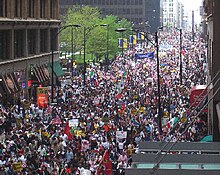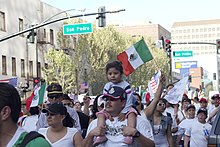2006 United States immigration reform protests
4437, which would raise penalties for illegal immigration and classify undocumented individuals and anyone who helped them enter or remain in the US as felons.
The 2006 immigration protests were a series of demonstrations that began in Chicago and continued throughout major cities nationwide for a period of eight weeks.
[3] Organizers of La Gran Marcha, however, state that the actual revised number of participants is somewhere between 1.25 and 1.5 million estimated through later photographic analysis.
[1] Since the 19th century, mass illegal immigration from Latin American countries to the United States has greatly impacted Latino politics.
In 1965, the United States passed the Immigration Nationality Act and repealed the 1924 National Origins Act designed to limit migration from southern and eastern European countries,[11] thus making it possible for eastern-hemisphere countries to have equal access to visas in addition and consequently restricting migration from the western hemisphere for the first time.
[11] The 1965 Act influenced Latinos/as citizens and permanent residents to request visas that allowed their family members to immigrate to the United States.
This resulted in a shift of the country's ethno racial makeup and the creation of a large Latino population in the United States.
First, the Act made it illegal for employers to hire workers who could not provide proof of legal immigration to the United States.
Second, it allowed for the legalization of immigrants who could prove residency in the U.S. since January 1, 1982 and agricultural workers who began working in the United States prior to May 1986.
As a result, the U.S. government began to increase the funding of Border Patrol as a means to regulate the flow of undocumented immigrants to the United States.
[13] Spanish-language media outlets, in particular Univision, Telemundo, Azteca América and La Opinión (Los Angeles' largest Spanish newspaper), advertised the protests on their front page.
The Piolín's radio show, recorded near Los Angeles, is broadcast in 47 markets across the country including Chicago, Dallas, Houston, Miami, Phoenix, San Francisco and New York, many of the cities where the protests took place.
[17] In addition to mobilizing thousands of immigrant protestors, Eddie "Piolin" Sotelo made multiple appearances during protests, which increased his moral authority towards his Latino audience.
Cardinal Mahony made an official statement against HR-4437 through which he instructed Catholic priests to defy any law that required them to ask immigrants for legal documents.
The next day the police arrested the leader of the Border Guardians, Roy Warden, for charges including assault and starting a fire in a public park.
[24] In addition, California's Oceanside Unified School District banned flags and signs from its campuses after "Mexican flag-wavers clashed with U.S.
On May 3, responding to the May 1 boycotts, the Minutemen embarked on a caravan across the United States in an effort to bring attention to a need for border enforcement.
One of those consequences was intensive Immigration Customs Enforcement (ICE) raids during the final years of the Bush administration which continued throughout the Obama presidency.
1070, which led to racial profiling and required police officers to request legal documentation from anyone they suspected was undocumented.
Both laws, along with similar others, were deemed unconstitutional in part because the U.S. Constitution assigns control over immigration to the federal government, not individual states.
Public opinion in the Latino community showed clear development based on both temporal and spacial exposure to the protests.
4437 (The Border Protection, Anti terrorism, and Illegal Immigration Control Act of 2005) was passed by the United States House of Representatives on December 16, 2005, by a vote of 239 to 182.
The House Republican leadership stated that it rejected S. 2611 wholly and would only pass legislation that addressed border security.
[72][73] The following organizations mobilized from hundreds (FAIR) to millions of people (Great American Boycott) around immigration reform in the United States during 2006.
Typically anti-illegal immigration movements focus on grassroots recruiting tactics; the Minutemen Civil Defense Corps and Minuteman Project use these methods to boost membership.



